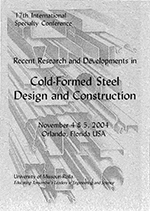Session Dates
04 Nov 2004 - 05 Nov 2004
Abstract
An experimental study was performed to investigate the ultimate strength and modes of failure of axially loaded channel rack columns with rear flanges. A total of 16 column specimens fabricated by press-brake forming method were tested up to failure. The material properties of the column specimens were determined using standard tensile coupon tests. The deformation and stress behavior of the tested columns were monitored using displacement transducers and strain gauges. The effects of column slenderness ratio, thickness, perforation, and end conditions on the column ultimate strength and mode of failure were studied. The test failure loads were compared to the ultimate load predictions of the 2001 AISI North American Specification. The comparison showed that the AISI procedure overestimates the failure load, which suggests that the proportioning of the cross-sectional dimensions of the lipped channel sections with rear flanges has a direct effect on the capacity of the columns.
Department(s)
Civil, Architectural and Environmental Engineering
Research Center/Lab(s)
Wei-Wen Yu Center for Cold-Formed Steel Structures
Meeting Name
17th International Specialty Conference on Cold-Formed Steel Structures
Publisher
University of Missouri--Rolla
Document Version
Final Version
Rights
© 2004 University of Missouri--Rolla, All rights reserved.
Document Type
Article - Conference proceedings
File Type
text
Language
English
Recommended Citation
Abdel-Rahman, Nabil; Fadel, Ashraf; EI-Sadaawy, Mohamed; and Mourad, Sherif, "Tests of Storage Rack Channel Columns with Rear Flanges" (2004). CCFSS Proceedings of International Specialty Conference on Cold-Formed Steel Structures (1971 - 2018). 3.
https://scholarsmine.mst.edu/isccss/17iccfss/17iccfss-session4/3
Tests of Storage Rack Channel Columns with Rear Flanges
An experimental study was performed to investigate the ultimate strength and modes of failure of axially loaded channel rack columns with rear flanges. A total of 16 column specimens fabricated by press-brake forming method were tested up to failure. The material properties of the column specimens were determined using standard tensile coupon tests. The deformation and stress behavior of the tested columns were monitored using displacement transducers and strain gauges. The effects of column slenderness ratio, thickness, perforation, and end conditions on the column ultimate strength and mode of failure were studied. The test failure loads were compared to the ultimate load predictions of the 2001 AISI North American Specification. The comparison showed that the AISI procedure overestimates the failure load, which suggests that the proportioning of the cross-sectional dimensions of the lipped channel sections with rear flanges has a direct effect on the capacity of the columns.



